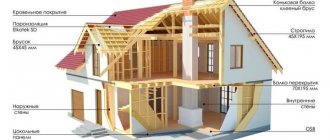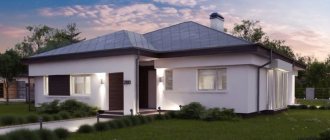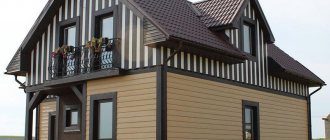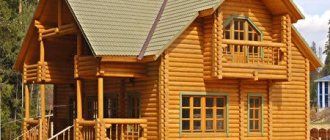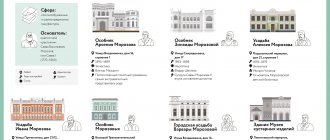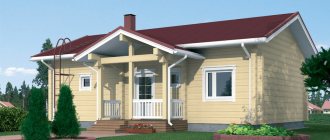Unique new generation houses made from Neo SML panels with a high degree of readiness.
We present a unique Russian technology for private housing construction.
For more than 10 years, we have been dealing only with new generation SML houses (including producing them at factories in Moscow, St. Petersburg, Kazakhstan, Tyumen and Crimea). During this time, we have become professionals and experts in this technology and know everything about it.
Our houses are superior to houses made of wood concrete and aerated concrete - If you are considering these technologies - about the advantages of SML houses here Our houses are superior to houses made of wood and frame houses - If you have considered these technologies - about the advantages of SML houses here. Our houses are superior to SIP - If You have considered this technology - about the advantages of SML houses here.
have our own architectural and design department. We can prepare a project of any complexity. Taking into account the individual characteristics of your site.
We will produce at our own factories and professionally build a modern cottage with our teams in compliance with all building codes and regulations. Interesting prices . Three-stage quality control. Construction time guarantees. More details
At the design stage, we think through all internal networks . This allows you to quickly and without extra costs build either a high-readiness warm circuit or a turnkey house. We carry out internal networks and finishing works of any complexity. We carry out ground and basement floors , long-span floors , flat roofs , floor-to-ceiling glazing . We organize visits to built houses in the Moscow region and in 40 regions of Russia!
Our panels are supplied to the European Union! 8-800-100-09-16
And now about our unique SML houses Neo Ver3.0
“The most capital of the prefabricated ones. The fastest of capital"
We recommend Neo SML houses made from new generation panels of a high degree of readiness (this is its official name) if:
- We need a modern house with high ecology ;
- there is no main gas on the site, and you need a house for permanent residence, which can be inexpensively heated even with electricity ;
- you need to quickly build a finished house and move into it, but you are not ready to buy a SIP or frame - we build Neo SML-houses on a turnkey basis in 3-4 months, a warm circuit in 1-1.5 months;
- I want aerated concrete, but there are reasonable doubts or there is no main gas for heating - our permanent house can be inexpensively heated even with electricity!
- I want a permanent house, but the site has weak soils - our houses can be built on all types of foundations, including lightweight options;
- you need an individual house designed specifically for your site and your family needs - this is how we design houses (including remotely);
- you need to optimize the budget of a finished house “TURNKEY” - the cost of our turnkey houses will pleasantly surprise you!
More information about SML panel technology:
- Marked by State support, recognized as innovative, certified .
- Received a Diploma of the National Award in the field of Ecology for the development and production of environmentally friendly products (Skolkovo).
- A report was made about the houses at the Public Chamber of Russia on the topic “Modern energy-efficient construction.”
- On the Moscow-24 in the information program “Life in a Big City”, on NTV about modern heating systems and on the Russia1 channel (videos on the right of the page).
- Houses were built in 40 regions of Russia, from Murmansk to Crimea, from Kaliningrad to Altai.
Construction of comfortable housing in Moscow and the region
Our company offers luxury housing in Moscow and the Moscow region on favorable terms. If you order construction according to a ready-made project, you will receive the following advantages:
- quick construction time - there is no need to do calculations, all documents are already ready;
- prompt paperwork with government agencies for the commissioning of housing;
- reasonable price - you know in advance the cost of the work, which has already been calculated for a specific project.
Our mission: Modern-Fast-Capital.
We to the advantages of modern prefabricated technologies ( FAST AND WARM) :
CAPITAL:
- walls made of panels with SML (thin sheet concrete);
- power racks made of wood, as well as concrete;
- insulation: basalt slab Rockwool, PPS or PIR;
- concrete on floors is possible;
- fire resistance corresponds to stone walls;
- high acoustic comfort of walls and heavy ceilings;
MODERN:
- ecology of the highest level (products received the Diploma of the National Award in the field of Ecology);
- energy efficient ( with our developments it is easy to heat a house without mains gas ) - our houses have been operating in the Arctic Circle since 2011;
- high degree of resistance to adverse influences (seismic resistance, moisture resistance, fire safety);
- the combined wall allows you to exceed the most stringent European energy efficiency standards for passive houses (the coefficient of wall resistance to energy transmission is more than 7.0);
- new systems in all our homes: installation of the Smart Home system, controlled ventilation, personal account on the Internet, control via smartphone.
In our houses we can make basement floors from stone panels . We are the only ones in Russia who have this technology. It allows you to quickly and inexpensively build a basement or ground floor.
the latest photos: construction , foundations, finishing, networks, wells and septic tanks here. There are also two photo galleries: gallery_1 and gallery_2. We are also constantly on social networks . Latest videos are always here.
Guarantees: high quality, minimum terms and fair prices due to:
- design, production and construction are in the same hands;
- full product certification;
- the technology was supported by the State, allocating state support for its implementation;
- factory production of high-quality house kits;
- payment for all work in stages;
- Leading banking structures work with us: Sberbank, RSKH, VTB and well-known insurance companies;
- We were chosen by consumers from the European Union.
Three options for building houses: 1. Houses made of panels with PPS insulation or Rockwool basalt with a wooden frame. 2. Houses made of panels with PPS insulation or Rockwool basalt with a reinforced concrete frame. 3. T-structure houses (combines the technology of panels and double spatial frame) - more details here.
The most common are houses made of panels with PPS insulation or basalt with a wooden frame . We offer them in two price groups, which differ in the type of foundation, type of ground floor, and floor height .
First price group: “Excellent House ” - these are energy-efficient, heavy capital houses . For them, reinforced concrete foundations are used, ready-mixed concrete on the ground floor of the first floor, powerful interfloor ceilings with the possibility of making a concrete screed over them. Either the best Russian brand PPS-16F (Novoplast) with a thickness of 150 or 200 mm is used as insulation in the panels. Or Rockwool basalt slab . In terms of characteristics, these houses are equal to houses made of aerated concrete. But they are more interesting in terms of prices, speed of construction and heating costs.
houses of the “ Olichny Dom” to those who want a thorough and solid :
- you need to quickly build a permanent house at a reasonable price ;
- I want aerated concrete, but I need an energy-efficient house, since there is no main gas for heating (at the same time, the person does not want to buy SIP);
- I want aerated concrete, but the site has weak soils ;
- there is no way for heavy equipment to drive to the construction site;
- construction is planned in a ready-made cottage community (neighbors are not ready to endure long-term stone construction under their windows; it must be built without causing damage to finished roads and relationships with others);
- you need to optimize the budget for a turnkey house.
Second price group: “Good House” is a modern prefabricated house with an optimal budget. In terms of characteristics and budget, these houses are a competitor to SIPs and high-quality frame houses. Panels with branded PPS-16F and pile-screw foundations are used. The unique properties of our panels allow us to build energy-efficient houses with excellent ecology, high fire safety, moisture resistance and sound insulation. These are prefabricated capital houses of a new generation.
Calculation of construction for these price groups is at the bottom right in the “Calculation calculator” . If you want us to call you back, enter your phone number in the calculator field. Or call: 8 800 100 09 16
The calculation accuracy is high: in fact, the deviation is no more than 5%!
We can also build houses with a reinforced concrete frame . This will lead to an increase in construction costs by 1,500 rubles/m2 based on the area of the house.
T-structure houses (combines panels and a double spatial frame) to comply with European energy efficiency standards. They are 2.5-3.0 times higher than Russian requirements and make it possible to obtain a passive house.
Short video “About us in two minutes.”
Vast construction experience has been accumulated . More than 540 houses were built. The combined efforts of the best specialists created a complete chain: DESIGN - PRODUCTION - CONSTRUCTION.
PROFESSIONAL DESIGN - modern examples of design - here
PRODUCTION (Moscow, St. Petersburg, Kazakhstan, Tyumen, Crimea)
CONSTRUCTION OF HOUSES - from “house box” or “closed warm circuit” to “completely turnkey”.
| In chapter STOCK : |
|
|
The deadline for the construction of new cities in Siberia under the “Shoigu project” has been announced
“We need to build three, or better yet five, large scientific, industrial and economic centers in Siberia. Simply put, cities with a population of 300–500 thousand, better – up to a million people,” said Sergei Shoigu at a meeting with the scientific community of the Siberian Branch of the Russian Academy of Sciences in early August.
Now the minister, and part-time head of the Russian Geographical Society, has given more detailed explanations of the large-scale plan for the development of agglomerations in Siberia that he mentioned. In particular, he mentioned the possible “linking” of future cities to specific places on the map of Siberia.
In his just published answers to RBC's questions on this topic, Sergei Kuzhugetovich mentioned, for example, that new large industrial centers can be created in the Krasnoyarsk Territory. According to the minister, “in the Kansk region there is potential to create a coal chemical production of popular plastics from illiquid raw materials. There is sufficient potential around Lesosibirsk to create a “Timber and Construction Materials” cluster with a high share of upstream products and an attractive economy.”
Shoigu also mentioned one more geographical localization in relation to his plans. “An industrial center with an attractive economy and long-term growth potential can be created between Bratsk and Krasnoyarsk.” Copper and Electrical Engineering. There are all possibilities not only for mining, but also for deep processing of copper and various rare earth metals for the subsequent production of domestic products with high added value.”
There is reason to believe that a new industrial giant and a city of miners and metallurgists “attached” to it will appear in the Irkutsk region in the area of the Bolshetagninskoye and Beloziminskoye tantalum, niobium, and fluorite deposits discovered by geologists and prepared for industrial development, located a hundred kilometers south of the city of Tulun. These deposits are mentioned in the “Report on the state and prospects for the use of the mineral resource base of the Irkutsk region,” prepared in the spring of this year. There they are described as “the most interesting”, the development of which “could become a promising direction for the economic development of the region.” According to experts, published in the multi-volume book “Economy of the Irkutsk Region,” it is advisable to create “the production of tantalum-niobium concentrate. ...It is possible to build a mining and processing plant. The reserves of the Beloziminskoye deposit alone will make it possible to supply the entire domestic industry with concentrate for a sufficiently long period of time and create a reserve for export. At the same time, the cost of concentrate at the Beloziminsky GOK can be several times lower than at other similar enterprises in the country and in the world.”
Shortly after Shoigu’s August speech to Siberian scientists, references appeared on information portals about the most likely “first-born” from the “Shoigu list.” We may be talking about reviving a once-existing plan to create a research and production center on the border of the Krasnoyarsk Territory and Khakassia.
Thanks to the proposals made by Sergei Kuzhugetovich, the name Elektrograd appeared in the media. The epic with the implementation of this global industrial project is relatively recent, but already thoroughly forgotten.
In the late 1970s, the Soviet leadership supported the idea of creating a large industrial zone near Minusinsk. As we would say now, a cluster was supposed to appear here - 12 factories producing electronics, electric motors, turbogenerators... All products are at the most modern world level.
Construction began in 1973. They decided not to spare money: in total, it was planned to invest more than 10 billion rubles in this project (to understand the enormity of the amount, it is enough to compare it, say, with the budget of the entire Union for 1984: 88 billion). To increase the pace of construction, a proven method was used in 1976 - Elektrograd was declared an All-Union shock construction site. Thanks to generous funding and the involvement of large human resources, within 2 years it was possible to put into operation the first industrial enterprise of Elektrograd - a special equipment plant. Among his products were items that were unique for that time. For example, a device for plasma cutting of metals, an automatic line for the production of batteries... In 1980, a second plant opened its doors, specializing in the production of then unique vacuum circuit breakers.
To meet the needs of ultra-modern enterprises, special design bureaus and training centers for technical and engineering workers were created... Alas, such breakthrough projects faced a shortage of personnel from the very beginning. It turned out that there are not many qualified specialists willing to go to the Minusinsk wilderness. The situation turned out to be so hopeless that it even provoked a sharp slowdown in construction work at other Electrograd sites. In one of the issues of the magazine “Technology for Youth” for 1984 they wrote about this: “...Unfortunately, many of them have become “long-term construction”. And this after such rapid development...”
Subsequently, the problems only worsened. With the beginning of the all-Union “turmoil” of the second half of the 1980s - early 1990s. even both already operating Elektrograd factories with their miracle products turned out to be unprofitable in the conditions of “wild” capitalism developing in the country. As a result, both factories soon closed. Most of their equipment was sold for scrap. As one of those who visited the ex-Electrograd these days said, “only destroyed workshops and piles of unbuilt production buildings remained there.”
So, now, after several decades, the industrial-scientific Electrocity can be reborn “from the ashes,” but in a new look?
The MK correspondent listened to experts whose opinions were divided.
"Siberian Curse"
“If I can express my feelings about the plans announced by Sergei Shoigu in one word, I can say: ambitious,” began our conversation with geo-urbanist, senior researcher at the Institute of Geography of the Russian Academy of Sciences Maria Gunko. – Of course, in the past there were cases when completely new cities were built in our country in undeveloped areas in difficult natural conditions. But these projects were carried out mainly by forced laborers - exiles, prisoners. In modern conditions, we do not have the opportunity to use free labor. This means that large financial resources will be needed to attract people to create new industrial centers from scratch.
But even if resources are found, the question arises about the further survival of such settlements. There is a book called “The Siberian Curse”, which describes the problem of keeping similar infrastructure projects built during the Soviet era afloat. Logistics there are expensive, and ensuring their normal functioning and the normal life of the inhabitants requires large expenses. These cities and towns are ineffective compared to similar settlements located in Central Russia, in the so-called main settlement zone.
Another point also related to costs. In the areas where new Siberian cities will be built, natural conditions are more severe. This significantly increases the cost of construction of housing, industrial and social facilities: more materials are needed, and these materials must be more expensive.
Finally, considerable financial resources will be required to attract businesses that will work there, creating jobs, to attract people to the newly built cities in Siberia - they will have to promise high salaries.
We do not live in an era when we can so easily start building a new city from scratch in the middle of nowhere. Now people are free to choose where they want to live and work. Therefore, it seems to me that these projects would be more in demand in the middle of the twentieth century.
In my opinion, even if our state finds funds sufficient to build such Siberian miracle cities of the future, it would be better to invest them in the modernization and reconstruction of already existing cities - the same Siberian, Far Eastern ones. Improve the infrastructure, transport and social conditions there. Then there would be much fewer people seeking to leave for the “comfortable” European part of the country.”
“It’s all possible to do this”
“I consider the doubts I heard from some colleagues to be too “concentrated,” argues sociologist Valery Uskov. – Let’s take at least one of the points: human resources. I would like to emphasize right away that in the history of our country there have already been several “waves” of mass migrations from the European part of the country to the Trans-Urals. At the same time, we will not take into account “coercion” - the stages of exiles and Gulag prisoners. There are examples of an organized, thanks to state preferences, flow of people wishing to leave for permanent residence in Siberia and the Far East. This was under Russian Prime Minister Stolypin, this was in the 1930s and 1950s, when the country's leadership actively pursued a policy of developing Russia's Asian expanses.
As for the examples of the Soviet era, ideological factors played a significant role there, and patriotic enthusiasm was cultivated in every possible way among young people: if you allow the conquest of Siberia, we will build a “garden city” in the taiga!
These days are purely mercantile times. Just like that, “for the sake of an idea,” it’s unlikely that anyone will want to take off and go to the Siberian wilderness. However, the state may well “provoke” such migration activity among citizens, especially young people. To do this, it is enough, for example, to “turn on the social elevators at full speed”—to provide, in the conditions of the new industrial center, real opportunities for rapid career growth for the workers who arrive there. Surely this will push many members of the younger generation to move from the European part of the country, where the prospects for moving up the career ladder do not look so encouraging for them. At the same time, it is possible to create conditions for immigrants to accelerate their training in the specialties required in the new place. Another effective “bait” from the state is the provision of favorable conditions for admission to specialized universities: benefits are given for enrollment in budget-funded places. The most important role in attracting personnel to such new cities will be played by providing newcomers with apartments with the right to subsequently privatize them.
Surely, among those wishing to become residents of new industrial and scientific centers in Siberia there may be many of our compatriots - ethnic Russians, millions of whom, after the collapse of the USSR, ended up in neighboring countries, and are now striving to settle on the territory of their historical homeland. To be honest, it’s not easy for many of these people to find a decent job in Russia right now. And in the case of new Siberian cities, they will have a real chance to get good living and working conditions. But, of course, in this case I mean sufficiently qualified workers, and not ordinary migrant workers...
In the case of Electrograd, which is now mentioned as a probable launch site, additional arguments can be found confirming the reality of this project. This territory, attempts to develop which have already been made in the past and were not crowned with success due to purely external, national problems, is very convenient for creating such a “city of the future.” Experts emphasize that in those areas near Minusinsk there is already a fairly developed transport infrastructure - a railway, a highway. And this is the most important plus in this case. In addition, nearby is the source of supplying the future city and its enterprises with cheap electricity - powerful power plants on the Yenisei.
Another “advantage” of the idea expressed by Minister Shoigu, in my opinion, is the absence in the plans he outlined of the totality characteristic of his Soviet-era predecessors. At the time of the development of socialism in the country, such projects were approached with a maximalist approach. The development of the Virgin Lands, the industrial development of the Far East, the turn of the Siberian rivers - this implied an offensive “along the entire front.” But such an “assault” requires prohibitively large resources – material and human. In the case of “cities from Shoigu” we are dealing with “infill development” of Siberia. To create such scientific and industrial centers that will become new growth points in the Trans-Ural region, it is quite possible to find everything necessary in modern Russia.”
Among those who approve the project of the Minister of Defense is the Deputy Chairman of the Siberian Branch of the Russian Academy of Sciences, Academician Nikolai Pokhilenko. In his interview with RIA Novosti, he said: “The idea is good, in principle, and we need to do it. Such centers are not a new experience. In many countries, large cities or satellite cities around them specialize in one serious industry... It’s easier to organize it all there. It’s easier to train personnel, it’s easier to create the appropriate infrastructure...”
The academician also explained what “levers” can be used to get such a large-scale project off the ground: “Political will and, at first, perhaps educational and explanatory work with business, which in our country is very inert. Here, on the one hand, with the help of a carrot, and on the other, maybe a little bit of a stick, this can all speed up. This is not just some decades. It’s possible to do all this within 5-7 years...”
Cities of the future...
In the Asian part of our huge country there are cities and large settlements that appeared in their time, thanks to strong-willed decisions made at the upper levels of power.
The main “heavyweight” among them is Novosibirsk. The largest metropolis in the Asian part of Russia today arose in 1893 practically “in the middle of an open field.” And this happened due to the ongoing large-scale construction - the construction of the Trans-Siberian Railway, which was strategically important for the country. 128 years ago, on the site of the current million-plus population stood the village of Krivoshchekovo, part of which had to be destroyed because it interfered with the laying of a rail track. But the construction of a bridge across the Ob, the construction of a railway station next to it with the necessary infrastructure - and, therefore, the associated increased need for workers and employees - contributed to the influx of residents. The station village, named Novonikolaevsky in honor of Emperor Nicholas II, continued to grow and 10 years later received the status of a city. Its development was facilitated by its convenient location next to the railway connecting the west and east of the country. Industrial enterprises were built here, educational institutions and branches of large banks were opened... Soon after the revolution, the city was made the administrative center of a huge region and renamed Novosibirsk. In the 1930s, the idea of “building America in Siberia,” which was then popular especially among young people, appeared. There were many projects to create new industrial enterprises in the still little developed east of the country. One of the actively growing centers of industrialization was to become Novosibirsk, which was even often called Sib-Chicago - “Siberian Chicago”. Here they began the construction of an agricultural machinery plant, factories for the production of metalworking machines, and mining equipment. The city continued to grow. The war gave an additional powerful impetus to this: several industrial enterprises from the European part of the country were evacuated to Novosibirsk, and specialists - engineers and workers - came with them.
The history of Komsomolsk-on-Amur is no less impressive. In the spring of 1932, teams of workers who arrived here landed on the bank of the mighty river near the small village of Perm. They had to implement the decree of the USSR Government on the creation of a large industrial center in the east of the country. Here, in the lower reaches of the Amur, based on the results of preliminary research, specialists identified a suitable location for two factories at once - a shipbuilding and an aviation one. These enterprises, important primarily for the needs of the military, quickly built brigades of enthusiastic Komsomol members sent on vouchers from all over the country, and “forced conquerors of nature” - prisoners. Already in 1936, a real city grew among the Far Eastern wilds, and two of its factories began producing products.
Among the “miracles created by the Soviets,” the West called the appearance of Norilsk, which now holds the honorary title of the northernmost city on earth with a population of more than 150 thousand people. This polar industrial center arose in the tundra among the desert expanses of the western spurs of the Putorana plateau in 1935. At that time, there were only a couple of houses built here in the early 1920s by members of a geological expedition that confirmed information about the presence of rich deposits of polymetallic ores in these places. To develop such a valuable deposit, the government decided to build a mining and metallurgical plant, and nearby a village for its workers. By decree of the Supreme Council of the RSFSR in the summer of 1953, Norilsk (this name was given to it from the name of the Norilskaya River flowing nearby) received the status of a city.
In the 1960s, after the discovery of the new Oktyabrsky deposit of copper-nickel ores, a new large mining city - Talnakh - appeared 30 kilometers from Norilsk in the same “magical” way, which since 2004 has been transferred to the status of one of the districts of Greater Norilsk.
Another example of the creation of a large settlement at an accelerated pace in the Siberian wilderness for its industrial development is Novy Urengoy. Natural gas was the culprit behind its birth. In the mid-1960s, prospectors confirmed the existence of a huge gas-bearing region in the north of Western Siberia. The “capital” of this newly developed mining territory became the village of Yagelnoye, which was then renamed Novy Urengoy and given the status of a city. In the second half of the 1970s, industrial exploitation of the local gas field began, and the city began to actively develop its infrastructure - new houses, schools, clinics were built, an airport became operational... Now about 120,000 people live in Novy Urengoy.
In the same area, in the neighborhood (if you measure distances by the Siberian “arshin”), several more fairly large settlements have recently emerged that are directly related to ensuring the exploitation of gas fields. Moreover, their “parents” - gas producing companies - used their “know-how” to solve the problem of creating such industrial centers in the Siberian Arctic. They began to build villages without a permanent population in areas where the development of new “natural reserves” of “blue fuel” is actively developing. People come there to work only for a certain period of time - on a shift. Having worked it, they return home, and in return a new batch of shift workers arrives. It is precisely these regular “landings” that support life in the northern villages of gas workers Yamburg and Sabetta.
Sergei Shoigu. Photo: Natalia Gubernatorova
...and the cities of the past
There are examples “with a minus sign” - when new centers of industry and natural resource development, created with great effort, sometimes at the cost of real labor feats, not only degraded after years, but turned into depopulated “ghost towns”.
The “dead city” of Ermakovo is located on the banks of the Yenisei near the Arctic Circle. Until relatively recently, it could be found on maps, although the last inhabitants left this place in the mid-1950s. But before that, Ermakovo was the “capital” of the “great Stalinist construction project” - the project to lay the Salekhard-Igarka railway. In 1949-1953 its population numbered more than 25,000 people. A river pier, a depot, a woodworking plant, schools, kindergartens, a community center, and even a theater were built here. However, after the death of the “leader of the peoples”, the project of the circumpolar “piece of iron” developed on his initiative turned out to be of no use to anyone. The construction of the already half-finished road was abandoned, and the people involved in it began to leave Ermakovo to find work in other places. Now in place of the former busy streets there is an impenetrable forest thicket, in the depths of which the wooden “boxes” of dozens of buildings are rotting...
The name of the village of Kadykchan in the Magadan region did not promise anything good from the very beginning of its existence. After all, translated from Evenki it means “Valley of Death”. This settlement, large by local standards, arose during the Great Patriotic War next to a coal deposit, the development of which was then decided to begin. The mine itself and the village were built - in the traditions of that time - by prisoners. Among them was Varlam Shalamov, who later became a famous writer. Subsequently, coal mining was expanded here, several more mines were opened, and the village grew significantly; at the beginning of 1986, more than 10,000 people lived there. However, with the onset of the crisis that led to the collapse of the USSR, these mining enterprises began to close one after another. The final line in Kadychkan’s biography came with the 1996 disaster. Then an explosion occurred at the still operating mine, killing several miners. The management considered it best to stop production altogether. All remaining employees were paid severance pay and asked to leave the town. To prevent anyone from being tempted to stay here, apartment buildings were cut off from electricity and heat supply, and some of the “huts” in the private sector were completely burned down.
We have to include in this gloomy “martyrology” Norilsk, mentioned in the previous top list of “successfully emerged”: it showed such “duplicity”. The fact is that at the end of the Soviet period, the polar city was supposed to grow with a new large district called Oganer. After all, according to optimistic plans, it was assumed that the population of Norilsk would continue to increase, and if so, you provide residential areas for new settlers! The new “dormitory” area in 1986 was designed according to the most modern principles at that time. Construction began in a big way, with the expectation that by 2020 more than 50,000 people would live there. Alas, the reality turned out to be much more modest. So soon the plans had to be adjusted. In the 1990s, it was decided to mothball most of the high-rise buildings being built until better times. According to available information, only about 10,000 Norilsk residents now live in those houses that were completed turnkey.
Functional mini-house with an area of 32 sq. m for a large family
First, we’ll show what portal user Artem Oganov (nickname on the IceAge portal) did.
The dimensions of the house are 6x6 m.
At the heart of the house is a cinder block garage that has been almost completely dismantled.
Thanks to a rational approach, the result was a comfortable mini-house for a young family.
The house stands on a slab foundation. The walls are made of aerated concrete and insulated with a 10 cm thick synthetic heat insulator.
The floor was insulated with EPS, 3 layers of 5 cm each.
IceAge FORUMHOUSE user
I built a mini-house as temporary housing for 2-3 years, for two adults and three children, as a replacement for a one-room apartment of the same area. In the future, it is planned to build a full-size cottage.
The mini-house aroused increased interest on the portal and a video was made about it.
The mini-house was built in one construction season.
The area of the attic floor is 21 square meters. m.
Despite its modest size, the house is in no way inferior to large cottages in terms of comfort.
When building a mini-house, you have to take into account hundreds of little things, and the design approach is often more complex than for a regular cottage.
Second light and correctly placed windows visually increase the internal volume of the room.
In the bathroom, with an area of 4 sq. m, located:
- toilet;
- sink;
- large cast iron bath;
- full-size washing machine;
- linen closet;
- boiler 100 liters;
- heating and underfloor heating unit (4 zones).
The “highlight” of the mini-house is the round windows on the gables, which offer beautiful views of nature.
Decorating the walls of a mini-house is a self-made shingle made from dead spruce.
The approximate budget for a mini-house is about 1 million rubles.
Project, wall pie, estimate and design features of a mini-house with an area of 26 square meters. m
Everyone has their own story about building a mini-house. Someone is solving a housing problem so as not to take on a mortgage, while someone wants to get a summer house in nature, for a pleasant time on weekends. For example, like Anna Musienko (nickname on the portal troll_on_wheels).
troll_on_wheels Member of FORUMHOUSE
I have a plot of 9 acres in a cottage village. I don’t have the funds to build a big house yet, and I don’t want to take out a loan. To develop the territory and for winter recreation, my family and I decided to build a frame mini-house, but not an ordinary one, but a designer one. In fact, it’s an analogue of a city apartment in nature with all the amenities.
Mini-house with an area of 26 sq. m.
The house comfortably accommodates two adults and two children + there is room for guests.
We will give the exact estimate of the mini-house below , and now the stages of its construction:
- The famous project of English architects is taken as a basis.
- 2. The project was redone taking into account the location of the house on the site and the requirements for the architecture of the building, which should not resemble a birdhouse.
Development of a house with an area of 26 square meters. m
The sloping rear wall of the mini-house was later abandoned to simplify and reduce the cost of construction.
The final version of the mini-house design.
The site has a slope, so screw piles with a diameter of 108 mm were chosen as the foundation.
Plan of the pile field.
Dimensions of a mini-house and plan.
- Start of construction of the mini-house frame.
Ready frame.
Frame structure close up.
The outside of the frame is covered with windproof fibreboard.
The inside of the frame was insulated and a vapor barrier was installed.
Pie of enclosing structures of a mini-house:
Roof (top to bottom)
- flexible tiles;
- underlay self-adhesive carpet;
- OSB 12 mm;
- sheathing;
- hydro-windproof vapor-permeable membrane;
- stone wool 5 cm thick, laid in 4 layers, total: 20 cm;
- vapor barrier;
- fine finishing.
Walls (from outside to inside):
- larch planken;
- sheathing;
- slab wind protection;
- vapor-permeable membrane;
- stone wool 5 cm thick, laid in 3 layers, total: 15 cm;
- vapor barrier;
- fine finishing.
Gender (top to bottom):
- porcelain tiles with wood texture;
- DSP 12 mm;
- EPPS (extruded polystyrene foam) 5 cm thick, laid in 4 layers, total: 20 cm.
- Electrical wiring has been done.
The plot offers excellent views of the forest.
- Covering the facade of a mini-house with larch planks
For discussion on the portal, troll_on_wheels offered 4 color options for a mini-house.
Installation of sheathing under larch planks.
Fastening larch planks with self-tapping screws.
Self-tapping screws ruined the aesthetics of the planken, so they were later replaced with nails. There is a 3 mm seam between the boards.
To attach the plank to the walls, it is better to use hidden fasteners.
- Flexible tiles were laid on the roof.
Estimate for the construction of a mini-house
Before we announce the costs of building a mini-house , we suggest watching a video about this unusual project.
troll_on_wheels
The mini-house can comfortably accommodate two adults and two children, and four more people if friends are visiting. In my opinion, it is better to live in a small, but nice and own house.
Costs for building a mini-house:
- The initial stage of construction (foundation, frame, insulation, etc.) - 450 thousand rubles.
- The second stage of construction (wall cladding, installation of communications, plumbing, flooring) - 400 thousand rubles.
- Another 110 thousand rubles were spent on furniture, lamps, and kitchen appliances.
Total budget for the construction of a mini-house: 960 thousand rubles.
A mini-house is not a mini-expense if you are building a beautiful house with all the amenities, and not a change house.
Demolition of an old house and construction of a new one: algorithm of actions
After receiving permission, the owner can begin work, which must strictly comply with safety regulations and urban planning regulations. The procedure should occur in the following order:
- Fences are pre-erected to prevent damage to neighboring areas.
- The house is disconnected from communications.
- The building is being demolished directly.
- The site is cleared of construction waste, removed and disposed of.
- A cadastral engineer is invited to record the fact of liquidation of the building and draw up an inspection report. This document will certify the absence of a residential building in the old location.
- A notification is submitted to the administration about the completion of demolition.
- The owner of the land and the former housing construction applies to the MFC to deregister it with the following documents:
- notification of the planned demolition with an administration note and permission;
- notification of completion of demolition also with a mark;
- inspection report issued by a cadastral engineer.
Next, Rosreestr makes changes to its databases, deleting the real estate with the specified cadastral number.
After this, the owner again contacts the local government through the MFC with notification of the start of construction of a new residential building. The procedure takes place in the usual manner, like ordinary new construction or reconstruction in compliance with the requirements of the Town Planning Code.
Step-by-step instructions for registering a house in SNT




